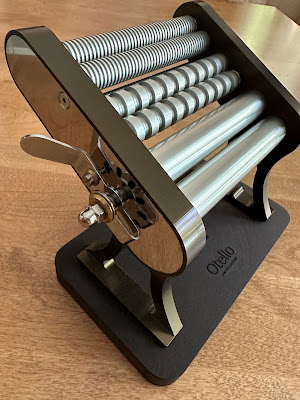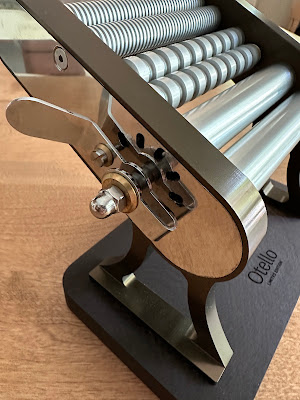Recently I was looking for an electric pasta machine that did not need to be clamped to a countertop or table. I ended up finding something very unique and not at all what I was looking for - a manual pasta machine that is a 90th anniversary replica of an original pasta machine from 1930!
The replica is named after Otello Marcato, who created the first manual pasta machine in 1930. This replica is a limited edition collector's item (that is meant to be used!) that came out some time in 2018, in celebration of Marcato's 90th anniversary as a company. Only 2,000 units were produced and they were all numbered on the wooden base. Out of curiosity, I looked all over the internet trying to find a photo of what the original pasta machine from 1930 looked like. This is the only photo I could find - it was on the Facebook page for Costante Imports in Australia and I'm not sure where they got the photo from, but I thought it was so cool! You can learn more about the history of the Marcato company on their website.
 |
| Original Marcato Pasta Machine from 1930 |
 |
| Marcato Otello Limited Edition Pasta Machine from 2018 |
 |
| Marcato Otello Heritage Line Pasta Machine |
In addition to not being able to find photos, I could not find much info on this limited edition pasta machine either. I found a few pasta makers on Instagram who have posted photos of it or videos of them using it, and a handful of reviews on websites online, but that's it. I believe this limited batch of 2,000 machines was introduced in the fall of 2018. I have seen it pictured in a few different colors.
 |
| Copper Bronze |
 |
| Gun Metal |
 |
| Sky Chrome |
There was a re-release of it at some point, although I'm not sure when, because the ones still available online today look different than the ones that were sold a few years ago. The shape of the base is different, the color is different, there is no plate with the new ones (and no holes for the plate, so the top looks different), and there is no number on the base on the current version. I had a hard time finding any in stock in the USA. The online retailer in Canada called Consiglio's had 2 left in stock, and also offered a 5% discount, no tax, and free shipping to the USA. This made the price lower than buying directly from the Marcato website, even with their introductory 10% off offer. I also noticed the price dropped $38 a few days after I placed my order, and I contacted their customer service to ask if they would refund me the difference and they did. I ended up paying $342 for it, which is not bad for something made this well, considering the regular price.
No attachments can be used with this machine (including a motor or other pasta cutters), so you can only use it to roll out pasta/lasagne sheets, cut fettuccine and cut tagliolini. The simplistic nature of it is part of what makes it so great to me. There are a lot of attachments available for the other pasta machines on the market but when I want spaghetti, I usually either want regular spaghetti or wide spaghetti, and if I want something different, I have my 4 KitchenAid attachments with various widths of pasta cutters that I can always use. The attachments on pasta machines also tend to fall off or shake when using, so I like that this is all one stable unit. It is also easy to set up - just take it out of the box, clamp it to the table or countertop and get started! The KitchenAid pasta attachments are fast which is great when making a lot of spaghetti, like my family does at Christmastime when we make 6 batches at a time to feed 50 people at Christmas dinner, however unless you have 2 mixers with one attachment on each, you have to keep changing the roller attachment out with the cutter attachment. With the Otello, you simply have to move the crank, which takes one second to do. The sound of the KitchenAid motor also makes my ears ring after a while. Using the Otello is nice and quiet, which I love! I found a few video tutorials on Marcato's YouTube page that are helpful to watch before using this machine for the first time.
My interest in purchasing this Otello pasta maker is to teach my kids how to make pasta the old school way, hand cranking it out, and then cooking it all for dinner for my family of 4 to enjoy. I don't intend to make more than one batch of pasta at a time using this machine, although it could certainly handle making a large quantity. Making pasta this way can also be very relaxing and soothing! Cooking and eating the spaghetti the same day we make it will also cut down on the time spent to freeze or dry the spaghetti like we have to do when making it in advance for holidays. We all love homemade spaghetti in my house and I'm hoping that making it together will become a more regular thing for our family to do. Yes, it is time-consuming, but that doesn't mean it should only be done once or twice a year in preparation for holidays or special occasions.
Today I used my Otello machine for the first time, using the recipe below, which is based off the recipe I make with my Mom at Christmastime (but I left the salt out of the dough because I heavily salt the boiling water instead). It was quite a bit of fettuccine for 4 people (I froze a little bit but we still had plenty that I cooked tonight left over, so this amount fed us two full dinners), so next time I will only make 4 or 5 eggs worth instead of 7 eggs! My 7 eggs came to exactly 360 grams so they were about 50 grams each, and I did not add any water. Every batch of dough will be slightly different but you should always weigh the flour and eggs for best results, and always use room temperature eggs. 4-5 eggs worth would be 400 grams flour and 240 grams eggs + water (100 grams dry ingredients to 60 grams wet ingredients) - I think I'll try that next time and see if it's the right amount to feed 4 of us. My dough seemed like the perfect consistency, but next time I might try using half semola flour and half 00 flour and see how that comes out, just to compare and see which I like better.
When I was rolling the dough out, I went to setting #5 on this machine, and the fettuccine seemed a little thin to me. This is the setting that Marcato recommends (they recommend setting #5 for fettuccine and setting #6 for tagliolini), but I just prefer it thicker.
Overall, this machine is really nice to use and the fettuccine was delicious! I have made spaghetti many times in my life, but this was the first time I've made an entire recipe using a hand crank machine instead of a motorized pasta machine like my KitchenAid attachments. It took me about an hour and a half to roll out all the sheets of dough and cut them, so it definitely takes more time than with the KitchenAid, but I found it fun and relaxing. The machine is also really nice looking and well-made. It was nice that I didn't have to mess with an attachment falling off or needing re-adjusted like sometimes happens with regular manual pasta machines.
I'm really excited to own this pasta machine. It is so unique looking and functional. I love that it is all one piece and solidly made in Italy. Most importantly, I'm looking forward to using it regularly and passing on my love of making homemade spaghetti to my boys.
Homemade Spaghetti Dough
600 grams flour (Anna "00" Flour)
360 grams organic brown eggs, room temperature
(about 6 or 7 eggs) + water (maybe 1/8 cup of water or so but not more than that, to add to the eggs to get to 360 grams)
Add all ingredients to a KitchenAid mixer bowl and mix until the dough comes together.
Knead the dough and shape into a ball, then cover with plastic wrap for at least 30 minutes.
Once ready, cut dough into small sections to roll out. Keep the rest of the dough covered so it does not dry out.
Roll dough using a pasta machine, several times on setting 1 (folding and flouring the dough between each pass through the machine), and then once each on settings 2-4, then twice on setting 5.
Cut the long sheet of pasta to your desired length (12" or so), flour it, then run it through your pasta cutter of choice (spaghetti, trenette, fettuccine, linguine, etc.).
Dry the spaghetti on a rack, separating the pieces so they don't stick together, or make into lightly floured "nests" and flash freeze on a cookie sheet, then store in a container in the freezer.
Drop the dry spaghetti or frozen nests directly into salted boiling water (do not defrost the frozen nests first). Homemade spaghetti cooks in just a few minutes.
Note: To make a smaller or larger batch of dough, use 100 grams dry ingredients to 60 grams wet ingredients.



















No comments:
Post a Comment